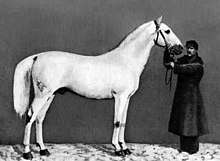Strelets Arab
The Strelets Arab or Strelets Horse is an extinct Ukrainian breed of light cavalry horse. It was bred in the nineteenth century at the Striletsky State Stud in Luhansk Oblast of Ukraine,[lower-alpha 1] from Arab and a variety of other stock. As with other Russian horse populations, its numbers were gravely reduced by the events of the Russian Revolution and the Russian Civil War, and it came close to disappearing. Two stallions and a few mares survived, which was judged to be too small a number to allow the breed to be recovered. Instead, they were taken to the Tersk Stud in the North Caucasus and used as the foundation stock in the development of the new Tersk breed of riding horse.[4]:258[3]:507 The Strelets also contributed to the development of the Don[5]:80 and Kustanai breeds.[4]:312[6]:294
 The Strelets stallion Bivouac, winner of a gold medal at the Exposition Universelle of 1867 | |
| Conservation status | extinct[1]:118[2] |
|---|---|
| Other names |
|
| Country of origin | Ukraine |
| Use | light cavalry horse |
| Traits | |
| Height |
|
| Colour | often grey |
History
The Strelets Arab was bred in the nineteenth century at the Striletsky State Stud[lower-alpha 1], near the village of Striltsivka, which at that time was in the Starobelsky district of the Kharkov Governorate of the Russian Empire, and is now in Milovsky Raion of Luhansk Oblast in easternmost Ukraine, close to the Russian border. It derived from a complex series of cross-breedings, initially of Arab and Anglo-Arab or Thoroughbred stock, later with some input from Karabakh, Orlov-Rostopchin, Persian and Turkmene horses.[7][8]:612 The predominant influence was that of the Arab, and the result was a horse of Arab appearance, but somewhat larger and faster.[8]:612 Among the Arab stallions used in the creation of the breed were Obayan Serebryany, a grey foaled in 1851; Tsiprian, foaled in 1875; and Tsenny, foaled in 1899, who was the sire of both Tsenitel and Tsilindr, the last two stallions of the breed survive.[7]
Characteristics
Notes
References
| Wikimedia Commons has media related to Strelets (horse). |
- Barbara Rischkowsky, D. Pilling (eds.) (2007). List of breeds documented in the Global Databank for Animal Genetic Resources, annex to The State of the World's Animal Genetic Resources for Food and Agriculture. Rome: Food and Agriculture Organization of the United Nations. ISBN 9789251057629. Accessed January 2017.
- Breed data sheet: Streletska (shooter's) / Ukraine (Horse). Domestic Animal Diversity Information System of the Food and Agriculture Organization of the United Nations. Accessed January 2020.
- Valerie Porter, Lawrence Alderson, Stephen J.G. Hall, D. Phillip Sponenberg (2016). Mason's World Encyclopedia of Livestock Breeds and Breeding (sixth edition). Wallingford: CABI. ISBN 9781780647944.
- Élise Rousseau, Yann Le Bris, Teresa Lavender Fagan (2017). Horses of the World. Princeton: Princeton University Press. ISBN 9780691167206.
- Elwyn Hartley Edwards (1994). The Encyclopedia of the Horse. London; New York; Stuttgart; Moscow: Dorling Kindersley. ISBN 0751301159.
- N.G. Dmitriev, L.K. Ernst (1989). Animal genetic resources of the USSR. FAO animal production and health paper 65. Rome: Food and Agriculture Organization of the United Nations. ISBN 9251025827. Archived 13 November 2009. Also available here, archived 29 September 2017.
- Tersky Horse and Streletsky Horse. Lexington, Kentucky: International Museum of the Horse. Archived 28 January 2020.
- Brian Seymour Vesey-FitzGerald (1946). The Book of the Horse. London; Brussels: Nicholson & Watson.
- Племінні господарства: Державне підприємство Стрілецький кінний завод № 60 (in Ukrainian). Institute of Animal Breeding, Ukrainian Academy of Agrarian Sciences. Accessed January 2020.